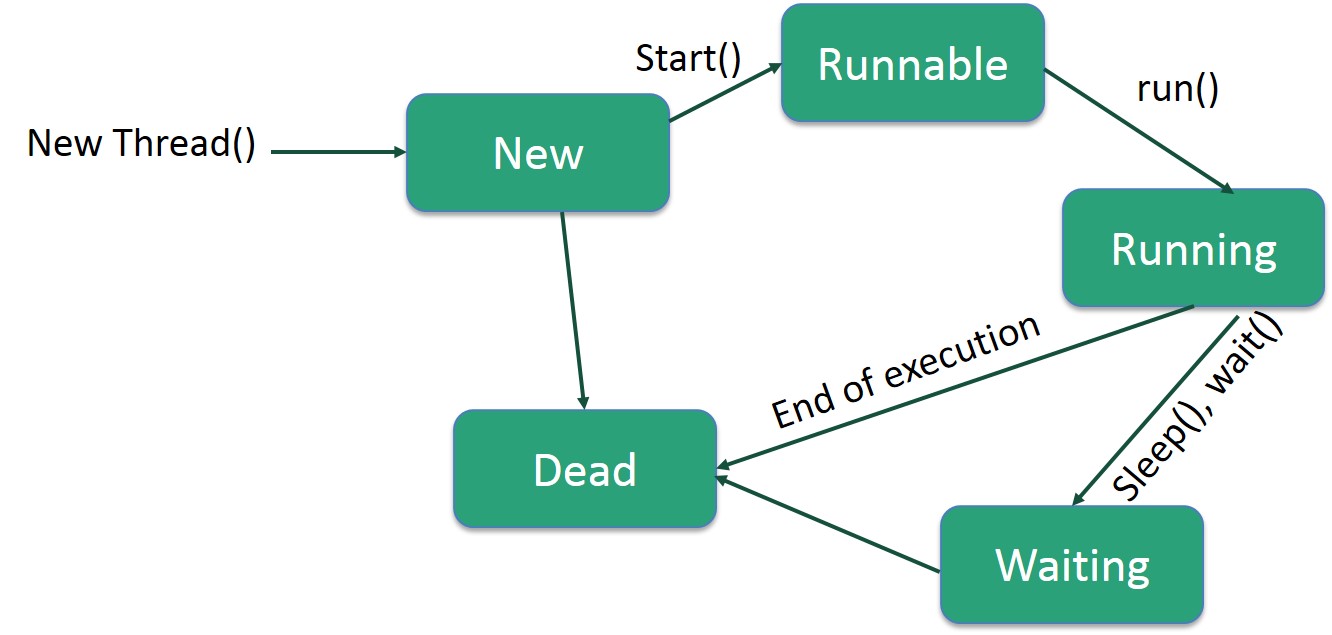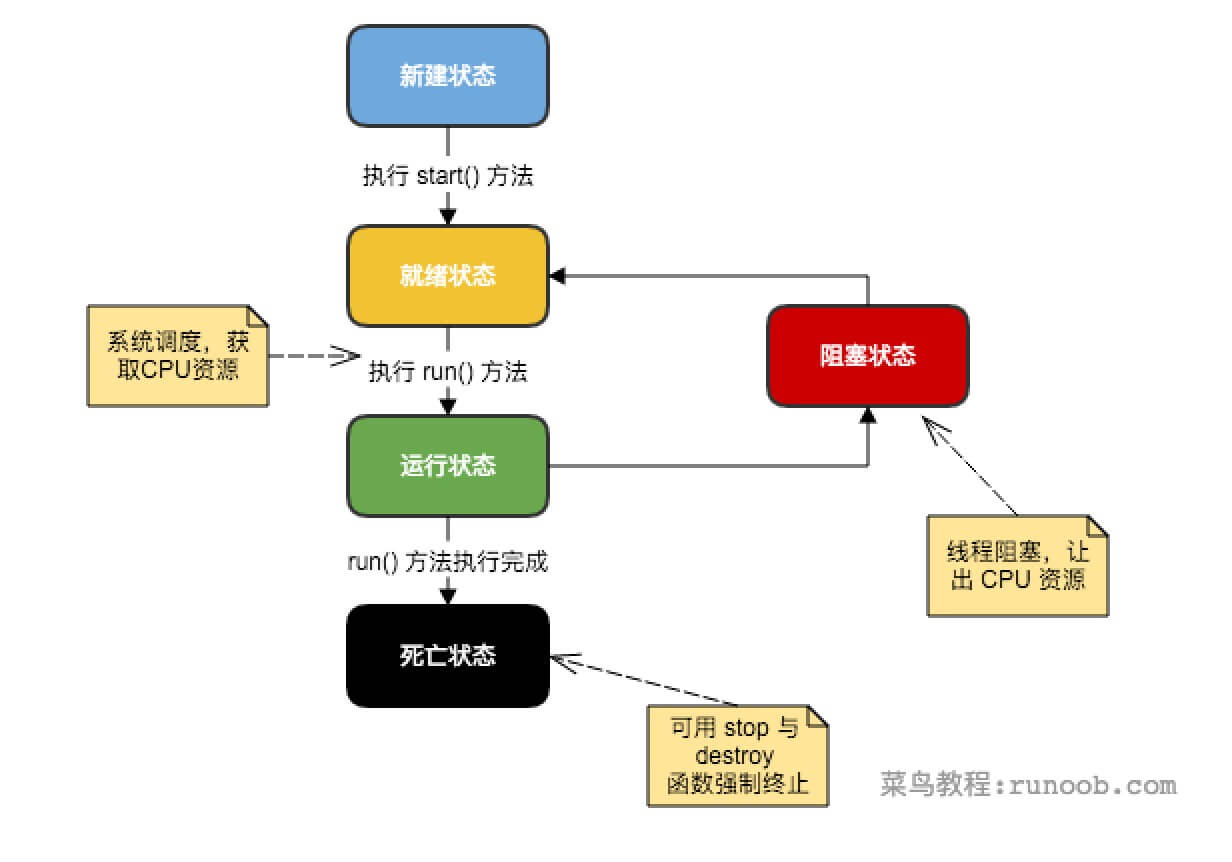Concurrency
Concurrency vs. Parallel
Concurrency - multiple tasks run simultaneoutly (Semantic Concept)
Parallel - multiple tasks physically run simultaneouly (Implementation level)
- Eg. multilane highway, multicore machines, Hadoop clusters
Explanations:
- Two definitions have nothing to do with the order of different tasks
- On a single core machine, we still have concurrency and parallel. (pretend to do so)
- 冯诺依曼体系:(每个核)一个时刻只能执行同一条指令。但是和上面概念不矛盾。
Ways to perform parallel programming (to physically launch multiple executors)
- Multiprocess
- multi-thread
- I/O multiplexing
Process vs. Thread
| Ways | memory space | call stack | heap | os resource |
|---|---|---|---|---|
| Process | independent | independent | independent | independent |
| Thread | shared | independent | shared | shared |
- Independent memory space is realized using virtual memory techniques in OS.
- Java concurrency is focusing on multithread cases in real life.
- 创建线程开销相对更小
Problems in multi-thread
- Communication overhead
- Resource isolation (fault tolerance)
- Creation/destroy overhead
Java Thread
Steps:
- create the thread objects
- each Java thread is mapped to one System thread (managed and scheduled by OS kernel rather than in user space)
- tell the threads what you want them to do
- start the thread
Ways of creating threads and make them running:
1) extends Thread
Thread t = new Thread() {
@Override
public void run(){
System.out.println("Hello");
}
};
t.start(); // schedule the created thread and make ready to go
//
// concurrency here
System.out.println("Main Thread"); // main thread
//
t.join(); // make sure the thread finished after this line
2) implements Runnable (for the purpose of being not conflict with single inheritence rule)
interface Runnable {
void run();
}
class HelloRunnable extends Client implements Runnable {
@Override
public void run(){
//..
}
}
Thread newThread = new Thread(new HelloRunnable());
newThread.start();
newThread.interrupt();
- When the JVM will exit?
- no alive non-daemon threads
- default thread is non-daemon
- create daemon thread using
Thread.setDaemon()method
- no alive non-daemon threads
Thread Operations
.start().run().join().sleep().yield()- 让出CPU资源。通常不需要手动使用。.interrupt()
How do we determine which line is run at each time?
- Scheduler + Queues: threads/processes are waited in queues, and there is a scheduler controls which thread/process is going to be run at the current time
- Each thread accepts a sequence of executed instructions


- Ways to block a thread
.sleep()/.suspend().wait()- wait for synchronized lock
.join()- other blocks
Synchronous procedure call Vs. Asynchronous procedure call
Thread or process synchronization#Thread_or_process_synchronization)
Thread synchronization is defined as a mechanism which ensures that two or more concurrent processes or threads do not simultaneously execute some particular program segment known as critical section.
异步调用的三种方式
- 单向调用:客户端发出请求之后不再关心服务端的情况
- 延迟响应:在第一次发出调用请求的时候,服务端需要返回一个称为票据(Ticket)的对象。客户端通过后续的调用查询请求结果。票据对象会作为第二次发出检索结果请求时的一个参数。(有些地方称为同步非阻塞,因为通过轮询方式不断地查询本身就是同步的)
- 请求回调:客户端发出调用请求,服务端立刻返回。服务端得到请求的结果之后,通过回调方式通知客户端触发响应。
关于Tornado
Tornado is a Python web framework and asynchronous networking library, originally developed at FriendFeed. By using non-blocking network I/O, Tornado can scale to tens of thousands of open connections, making it ideal for long polling, WebSockets, and other applications that require a long-lived connection to each user.
- Tornado provides asynchronous functions (in its library) to call
- Tornado ioloop is condition synchronization by epolling for non-blocking
- By using non-blocking I/O, we can increase our programme's performance
Synchronization & race
Synchronization - the coordination of events to operate a system in unison.
Impose orders on (previously) concurrent events. 我们人为提供时间执行的顺序。
How? Locks (synchronized), concurrent data structures, wait/notify (condition synchronization), volatile, ...
Data races - if two "conflicting operations" are in different threads and are not properly synchronized (concurrent), they will introduce data races.
冲突可能发生在CPU指令层次,最后会导致读操作对写操作产生影响。所以一定要同时对读操作和写操作采用合适的同步操作。
3 factors can form a data race
- More than one operations work on the same memory location
- At least one oepration is a
write - At least two of those opreations are concurrent
Mutual exclusion, critical section, and lock
The most typical way to get rid of data races: locks
Or, on the semantic side: mutual exculsion
lock锁的是代码不是资源
No two concurrent processes are in their critical section at the same time. And a critical section can be defined as:
A part of a multi-process program that may not be concureently executed by more than one of the program's processes/threads.
How to create a critical section?
- A general lock has two operations: lock and unlock.
- Lock: wait no one is there and go into the critical section
- Unlock: Leave the critical section and mark no one is here
Our goals in parallel programming
- Data race freedom
- determinism
Lock Granularity 粒度:
- coarse grained lock (CGL) 粗粒度锁
- fine grained lock (FGL) 细粒度锁
- critical section
- avoid super slow opeartions in a critical section, such as IO
Mutual exclusion in Java
- synchronized keyword
private int value;
public void increase() {
synchronized(this) {
value++;
}
}
public synchronized void decrease(){
value--;
}
- synchronized on non-static method == synchronized(this)
synchronized on static method == synchronized(Counter.class) != synchronized(all instances)
synchronizedMapis a wrapper ofMapconcurrentHashMapseparates HashMap into segements and perform sync operations on each one of them separately (sharding, federation).
Locks in Java
Lock L = ...;
l.lock();
try {
// access the resource protected by this lock
} finally {
l.unlock();
}
Dead Lock
- Defintion
- P1: holding Lock 1, trying to acquire Lock 2
- P2: holding Lock 2, trying to acquired Lock 1
- Conditions to form a deadlock
- Mutual Exclusion
- Cannot avoid. We want mutual exclusion for synchronization
- Hold and Wait or Resource Holding
- Can avoid by using one lock at a time
- No Preemption (抢占)
- Cannot avoid. We do not have this kind of mechanism sometimes
- Circular Wait
- Can avoid by arranging the order of locks
- Mutual Exclusion
Live Lock
live lock will happen if each side is actively resolving the problem (backoff and retry)
Solutions
- priority
- randomize
Atomicity
volatile
- guarantees visibility (semantically, happens-before), much like acquiring and releasing a lock.
- 为单个变量提供独占性,避免data race
- does not guarantee atomicity
- only guarantees single read/write operation is atomic. But in a read-then-update case (or more complicated), we want to gurantee
value++is atomic. - use
synchronizedorAtomicIntegerinstead - use double checked locking in Singleton case
- only guarantees single read/write operation is atomic. But in a read-then-update case (or more complicated), we want to gurantee
- Common use case
- flag to stop (read/write only for each thread)
public volatile boolean flag = false;
Condition synchronization
Think this in real life: wait for some important mail. I can:
- keep waiting there (very low efficiency)
- periodic check and go (better efficiency, but may delay, how long shall I wait?)
- use tracking service and notification it will send you messages when it comes! (high efficiency, almost no delay)
Here we can do similar things: instead of busy waiting or periodic checking, we need a mechanism to:
- allow threads to wait on a condition
- (Hopefully) Allow a thread satisfies the condition to notify all waiting threads
Producer consumer problem
Build a blocking queue, such that:
- when the queue is empty, consumer will wait until produce provide one element
- when the queue is full, producer will wait until consumer release one element
Both operations happens in a mutual exclusive fashion so that all operations are ordered.
- Mutual exclusive -> use locks
- Wait -> condition synchronization
What is Monitor?
- There are two queues controlling the access to enter the room.
- lock queue, there is only one thread at a time from the queue can enter
- wait queue, there is a queue for the condition provided, all the thread wait(), is in the queue, and wait for the notify() call to remove from the condition queue.
BlockingQueue Realization Using Wait NotifyAll
class Q {
private Queue<Integer> q;
private final int limit;
public Q(int limit) {
this.q = new LinkedList<>();
this.limit = limit;
}
public synchronized void put(Integer ele) {
while (q.size() == limit) {
try {
wait();
} catch (InterruptedException e) {
e.printStackTrace();
}
}
if (q.size() == 0) { // Comsumer wait under only on circumstance that the queue is empty.
notifyAll();
}
q.offer(ele);
}
public synchronized Integer take() {
while (q.size() == 0) {
try {
wait();
} catch (InterruptedException e) {
e.printStackTrack();
}
}
if (q.size() == limit) {
notifyAll();
}
return q.poll();
}
}